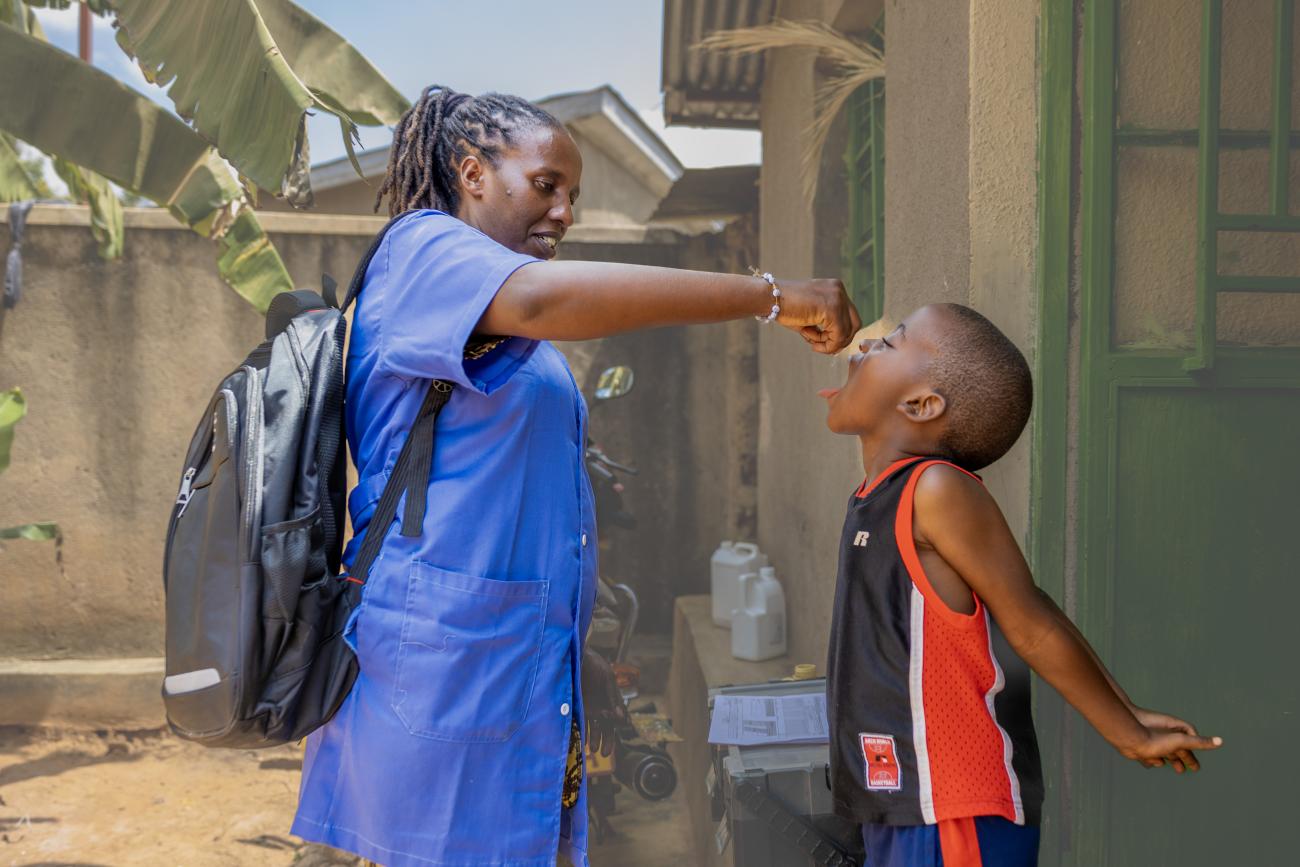Bringing Hope Door-to-Door: UN and Govt Join Forces to Vaccinate against Polio and Safeguard Public Health

.
There is a Kinyarwanda adage that goes like this: 'Iyo umuturanyi arwaje ibinyoro, ugura akarago!' It literally means that if one finds out that a neighbor is suffering from yaws, they take precautions because there is a possibility that they might be next.
Earlier this year, Burundi, the Democratic Republic of Congo (DRC), and Tanzania, three neighbouring countries of Rwanda, declared their first Polio outbreak in three decades. This led the World Health Organization (WHO) to trigger an epidemiological alert throughout the region and support synchronised Polio vaccination campaigns in countries at high risk.
The Ministry of Health, through the Rwanda Biomedical Centre (RBC), the United Nations Children's Fund (UNICEF), and the WHO and partners quickly took action to protect the population.
“The week of 24th to 30th July 2023 was dedicated to the first round of the Polio vaccination campaign targeting children aged 0 to 7 years old. We reintroduced the Type2 Polio vaccine through a countrywide Polio vaccination campaign to strengthen our children’s immune system.” Said Hassan Sibomana, the Immunization Programme Manager at RBC.
Rwanda removed the Type 2 Polio vaccine from its routine immunization in 2016 after Wild Poliovirus Type 2 was declared eradicated worldwide. After the declaration of circulating vaccine-derived polio virus type 2 outbreaks. However, the new alert urged the country to implement two rounds of house-to-house Polio vaccination campaigns to effectively respond to the circulating Vaccine Derived Polio Viruses type 2 (cVDPV2) outbreak declared in the region
A door-to-door Polio vaccination campaign
Seven years have passed since the country switched from trivalent Oral Polio Vaccine (tOPV), which contains types 1, 2, and 3, to bivalent (bOPV), which does not include type 2. This highlights the importance of immunity gaps among children born after the switch who are at high risk of cVDPV2 infection. For these reasons, campaigns targeted children of 0 to 7 years old countrywide. The launch of the second round of the polio vaccination took place on 11 September 2023, in Karongi district. Just like Nyanza where the first round was launched, these districts were among those considered at high risk due to their proximity to affected areas and vaccine refusals.
“This vaccination campaign was helpful and easy. It really made our lives easy. The fact that Community Health Workers came to our houses increased the success because if we were to go to the health centres, maybe some parents would find excuses and not participate,” said Charlotte Mukamukiza, happily holding her vaccinated baby.
The implementation of this nationwide polio vaccination campaign required 1,969 supervisors and 4,808 vaccination teams. All vaccination teams are made up of Community Health Workers (CHWs), trained before the campaign.
“We operated as a trio. One CHW would vaccinate, the second would record the child and mark the house while the third served as an advance in charge of social mobilization.” According to Gerard Kanimba, community and environmental health officer who supervised vaccination teams in Nyarugenge District.
Poliomyelitis is a highly infectious, yet preventable disease caused by a virus (poliovirus) that mainly affects children under 5 years of age. However, anyone of any age who is unvaccinated can contract the disease. One in 200 infections leads to irreversible paralysis. Among those paralysed, 5 to 10% die when their breathing muscles become immobilised. Those who survive the disease face lifelong consequences such as paralysis that requires leg braces, crutches, or wheelchairs, while others need breathing devices.
Results based delivery.
The United Nations’s two sister agencies WHO and UNICEF played a pivotal role in the door-to-door polio vaccination campaigns.
From planning to implementation, WHO supported the capacity building of frontline health workers, the establishment of an Emergency Operation Centre, support coordination of Polio SIAs planning, supportive supervision, and monitoring of the performance of the campaign.
UNICEF also worked hand in hand with the government to actively engage communities through interpersonal communication, media utilisation, oversight, and capacity building of national social and behaviour change professionals, to drive intensive community mobilisation efforts. Furthermore, the UN Children’s Fund was charged with comprehensive vaccine management, encompassing procurement, stock management, distribution, supervision, waste management, and the rigorous enforcement of safety control measures.
Both rounds of vaccination reached 2,915,598 children in Round One. The second-round targeted children who were reached in the first round, those who missed the first round, and babies born during the period between the first round and the last day of the second round. According to National Polio SIA results, round two reached 99.7% of the targeted children.
Due to the relatively high population movement across international borders, WHO considers the risk of an outbreak in Rwanda to be high.
“Whenever we detect cases of highly infectious diseases, it is WHO’s mandate to provide the necessary technical support and advocate for financial support for countries to have the capacity to protect populations at risk.” Said Dr Rosette Nahimana, Immunization technical officer at the WHO country office.
This Joint initiative also responds to various Sustainable Development Goals, especially SDG 3, “Good Health and Well-Being” and to the third output of strategic priorities of the UNSDCF to achieve the intended outcome “by 2024, people in Rwanda, particularly the most vulnerable, enjoy increased and equitable access to quality education, health, nutrition and water, sanitation, and hygiene (wash) services.”
Today, Rwanda maintains a workforce of nearly 60,000 workers who are trained to treat diseases such as Malaria and Diarrhea within the community, follow up on expectant mothers, and provide Family planning, nutrition, and hygiene interventions.
For over five years, the country has been able to achieve and sustain a vaccination coverage of 95% for the most common infectious vaccine-preventable diseases. An effective network of Community Health Workers is one of the reasons that it is globally recognised as a key driver of Rwanda’s early achievement of Millennium Development Goals.




